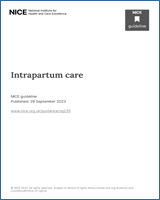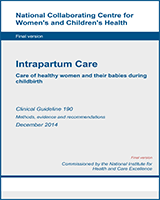NCBI Bookshelf. A service of the National Library of Medicine, National Institutes of Health.
Update information February 2017: Sections that have been updated (see addendum files) have been marked with dark grey shading.
Excerpt
The guideline is intended to cover the care of healthy women with uncomplicated pregnancies entering labour at low risk of developing intrapartum complications. In addition, recommendations are included that address the care of women who start labour as ‘low risk’ but who go on to develop complications. These include the care of women with prelabour rupture of membranes at term, care of the woman and baby when meconium is present, indications for continuous cardiotocography, interpretation of cardiotocography traces, and management of retained placenta and postpartum haemorrhage. Aspects of intrapartum care for women at risk of developing intrapartum complications are covered by a range of guidelines on specific conditions (see section 1.8) and a further guideline is planned on intrapartum care of women ‘at high risk’ of complications during pregnancy and the intrapartum period.
Contents
- Guideline Development Group membership and acknowledgements
- Guideline development group membership and acknowledgements 2014
- 1. Introduction
- 1.1. Aim of the guideline
- 1.2. Areas within the remit of the guideline
- 1.3. Areas outside the remit of the guideline
- 1.4. Areas within the remit of the updated guideline
- 1.5. For whom is the guideline intended
- 1.6. Who has developed the guideline?
- 1.7. Who has developed the guideline (update)
- 1.8. Other relevant documents
- 1.9. Guideline development methodology
- 1.10. Guideline development methodology for 2014 update
- 1.11. Schedule for updating the guideline
- 1.12. Explaining the changes in the partial update
- 2. Summary of recommendations and care pathway
- 3. Place of birth
- 4. Care throughout labour
- 5. Latent phase
- 6. Initial assessment at the onset of labour
- 7. Prelabour rupture of membranes at term
- 8. Coping with pain in labour – non-epidural
- 9. Pain relief in labour: regional analgesia
- 9.1. Regional analgesia
- 9.2. Regional analgesia versus other types of analgesia in labour
- 9.3. Timing of regional analgesia
- 9.4. Care and observations for women with regional analgesia in labour
- 9.5. Effect of epidural fentanyl on breastfeeding
- 9.6. Mode of administration
- 9.7. Establishing regional analgesia in labour
- 9.8. Maintenance of regional analgesia
- 10. Monitoring during labour
- 10.1. Cardiotocography compared with intermittent auscultation during established labour
- 10.2. Fetal heart rate monitoring for meconium-stained liquor
- 10.3. Interpretation of an electronic fetal heart rate trace
- 10.4. Predictive value of fetal scalp stimulation
- 10.5. Fetal blood sampling
- 10.6. Cardiotocography using telemetry compared with conventional cardiotocography
- 10.7. Women's views and experiences of fetal monitoring
- 10.8. Cardiotocography with fetal electrocardiogram analysis compared with cardiotocography alone
- 10.9. Computerised systems versus human interpretation
- 10.10. Record keeping for electronic fetal monitoring
- 10.11. Risk management in monitoring babies in labour
- 11. First stage of labour
- 11.1. Introduction
- 11.2. Definition of first stage of labour
- 11.3. Duration of the first stage of labour
- 11.4. Observations during the established first stage of labour
- 11.5. Possible routine interventions in first stage of labour
- 11.6. Interventions for perceived delay in the first stage of labour
- 11.7. Intrauterine resuscitation
- 11.8. Scoring systems for meconium-stained liquor
- 12. Second stage of labour
- 12.1. Definition of the second stage of labour
- 12.2. Observations for women and babies in the second stage of labour
- 12.3. Women's position and pushing in the second stage of labour
- 12.4. Pushing in the second stage
- 12.5. Duration and definition of delay in the second stage of labour
- 12.6. Delay in the second stage of labour
- 12.7. Intrapartum interventions to reduce perineal trauma
- 12.8. Water birth
- 12.9. Decision to delivery interval for vaginal birth
- 13. Third stage of labour
- 14. Care of the baby and woman immediately after birth
- 14.1. Introduction
- 14.2. Initial assessment of the newborn baby
- 14.3. Neonatal resuscitation
- 14.4. Routine paired cord-blood gas analysis
- 14.5. Care of babies born with meconium-stained liquor
- 14.6. Care of babies born to women with prelabour rupture of the membranes at term
- 14.7. Mother–infant bonding and promoting breastfeeding
- 14.8. Initial assessment of the mother following birth
- 14.9. Perineal care
- 15. Glossary and abbreviations
- 16. References
- Appendices
- Appendix A. Health economics
- Appendix B. Scope
- Appendix C. Stakeholders
- Appendix D. Declarations of interest
- Appendix E. Review protocols
- Appendix F. Collated search strategies
- Appendix G. Summary of identified studies
- Appendix H. Excluded studies
- Appendix I. Evidence tables
- Appendix J. GRADE tables
- Appendix K. Place of birth – neonatal outcome table
- Appendix L. Place of birth – decision aid
- Appendix M. Place of birth – sub-group analysis
- Appendix N. Fetal heart rate classifications
- Appendix O. Forest Plots
- Appendix P. Interpretation of CTGs – Likelihood ratios
- Appendix Q. Deleted material from previous guideline
- Appendix R. Care pathway
Disclaimer: Healthcare professionals are expected to take NICE clinical guidelines fully into account when exercising their clinical judgement. However, the guidance does not override the responsibility of healthcare professionals to make decisions appropriate to the circumstances of each patient, in consultation with the patient and/or their guardian or carer.
- Intrapartum care for healthy women and babies
- Addendum to intrapartum care: care for healthy women and babies
- Addendum to Clinical Guideline CG190, Intrapartum care for healthy women and babies
- 2019 surveillance of intrapartum care for healthy women and babies (NICE guideline CG190)
- Intrapartum Care: Care of Healthy Women and Their Babies During Childbirth (NICE guideline CG55)
- Review The prevention of early-onset neonatal group B streptococcal disease.[J Obstet Gynaecol Can. 2013]Review The prevention of early-onset neonatal group B streptococcal disease.Money D, Allen VM, INFECTIOUS DISEASES COMMITTEE. J Obstet Gynaecol Can. 2013 Oct; 35(10):939-948.
- Vaginal delivery of breech presentation.[J Obstet Gynaecol Can. 2009]Vaginal delivery of breech presentation.Kotaska A, Menticoglou S, Gagnon R, MATERNAL FETAL MEDICINE COMMITTEE. J Obstet Gynaecol Can. 2009 Jun; 31(6):557-566.
- Review The Birthplace in England national prospective cohort study: further analyses to enhance policy and service delivery decision-making for planned place of birth[ 2015]Review The Birthplace in England national prospective cohort study: further analyses to enhance policy and service delivery decision-making for planned place of birthHollowell J, Rowe R, Townend J, Knight M, Li Y, Linsell L, Redshaw M, Brocklehurst P, Macfarlane A, Marlow N, et al. 2015 Aug
- Adolescent Pregnancy Guidelines.[J Obstet Gynaecol Can. 2015]Adolescent Pregnancy Guidelines.Fleming N, O'Driscoll T, Becker G, Spitzer RF, CANPAGO COMMITTEE. J Obstet Gynaecol Can. 2015 Aug; 37(8):740-756.
- Predictability of intrapartum cardiotocography with meconium stained liquor and its correlation with perinatal outcome.[J Pak Med Assoc. 2018]Predictability of intrapartum cardiotocography with meconium stained liquor and its correlation with perinatal outcome.Husain A, Naseem A, Anjum S, Imran S, Arifuzzaman M, Adil SO. J Pak Med Assoc. 2018 Jul; 68(7):1014-1018.
- Intrapartum CareIntrapartum Care
Your browsing activity is empty.
Activity recording is turned off.
See more...

